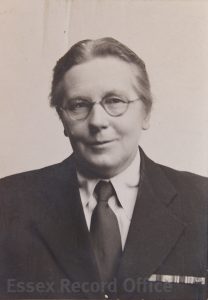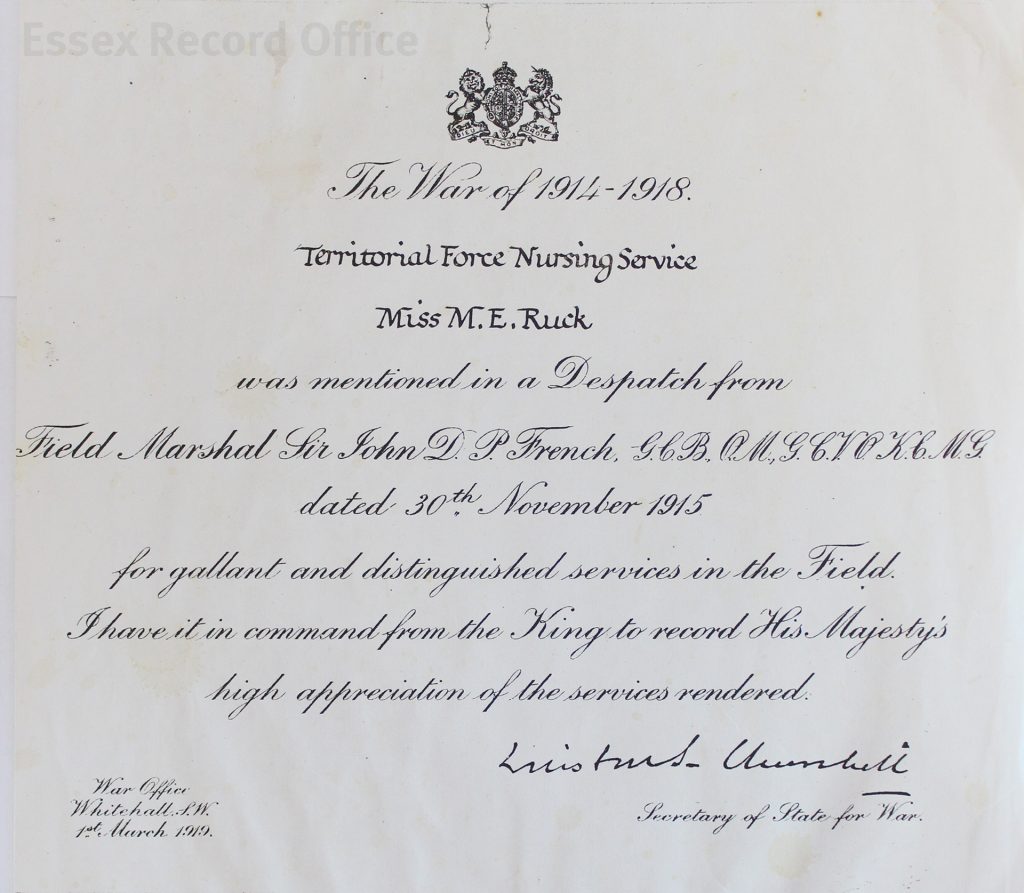Lawrence Barker, Archivist
 To celebrate International Nurses Day (marked each year on 12th May, Florence Nightingale’s birthday), we thought we’d take a look at the career of an eminent Essex nurse, Mary Ellen Ruck RRC, who served as the Matron of Black Notley Hospital near Braintree from 1929 to 1952.
To celebrate International Nurses Day (marked each year on 12th May, Florence Nightingale’s birthday), we thought we’d take a look at the career of an eminent Essex nurse, Mary Ellen Ruck RRC, who served as the Matron of Black Notley Hospital near Braintree from 1929 to 1952.
Among the records relating to her (A14768 box 3), which were deposited with Essex Record Office alongside other records of Black Notley Hospital last year, is a book which was presented to her at the time of her leaving listing all her colleagues and associates, including the former County Medical Officer of Health, W. A. Bullough, who described her in a testimonial in 1930 after only one year in office, as ‘a splendid organiser and administrator’ who had ‘rendered me able assistance’ in connection with a scheme for recruiting secondary school girls into the County’s nursing service.

The new Essex County Council Sanatorium at Black Notley for the treatment of Tuberculosis in women and children was opened on 26th April 1930, and the photograph below was probably taken at the time showing Nurse Ruck standing with the Minister of Health, Arthur Greenwood, the Bishop of Barking, W. A. Bullough and councillors and staff associated with the hospital.


The Ambulant Children’s Pavilion at Black Notley Sanitorium
Former staff who worked with her described her supervision as “firm but fair”. A nurse who joined the staff in 1950, described how Mary Ruck would work at night in the kitchen, how strict she was about cleanliness and in particular about the provision of good food. Apparently, she was also a great entertainer, famous for her summer strawberry and raspberry teas. She even concerned herself with the grounds of the hospital making certain that the gardeners looked after them properly so that they should look nice for the patients.[1] Her attention to cleanliness possibly accounts for the nick-name ‘Mops’ given to her by a friend and associate signing his photograph ‘John’, a Christmas greeting in 1938.
She continued, however, to be involved with nursing in Essex after leaving the sanatorium and was eventually appointed County Nursing Superintendent of the Essex branch of the British Red Cross Society on 1st November 1954.

But perhaps the most impressive part of Mary’s story dates back to before her arrival in Essex.
She originally came from Lincolnshire. According to her entry in the 1939 Register taken at Wanstead Hospital, she was born at Grantham on 22nd December 1886. In 1891, the family were living at Louth, her father working for the railway as a ticket collector. By 1901, he had become the Station Master of Dog Dyke on the Lincolnshire fens, memorably recalled in Flanders and Swann’s well-known song ‘The Slow Train’:
 On the Main Line and the Goods Siding
On the Main Line and the Goods Siding
The grass grows high
At Dog Dyke, Tumby Woodside
And Trouble House Halt
By 1911, she was a nurse at the Leeds General Infirmary where she completed her training in 1913. On the outbreak of the First World War, she joined the Territorial Force Nursing Service and was posted to France in January 1915. And from then she seems to have covered herself with glory. After the Battle of Ypres in 1915, she was mentioned in a despatch by Field Marshall Sir John French on 30 November, which was reported in a local Lincolnshire newspaper.
Among her records are a collection of negatives of photographs taken at Ypres showing the bombed city and Mary Ruck at her station in what looks like a field hospital hut presumably located by the battlefield.



In 1916, after the Battle of the Somme, she was decorated on the field with the Royal Red Cross 1st Class. The photograph below, thought to have been taken after the battle, shows her at the right-hand end of the back row of nurses.

Finally, after the war, she received a personal letter dated 1st March 1919 signed by Winston Churchill acknowledging her mention in despatches by Sir John French and conveying His Majesty the King’s ‘high appreciation’ of her gallant and distinguished service in the field.

During her long career in nursing Mary must have helped thousands and thousands of people, from soldiers wounded on the battlefields of the First World War to children suffering from tuberculosis. She lived to the age of 85, and died in 1969.
[1] Black Notley Hospital: a century of service, Black Notley Parish Council, 1998
